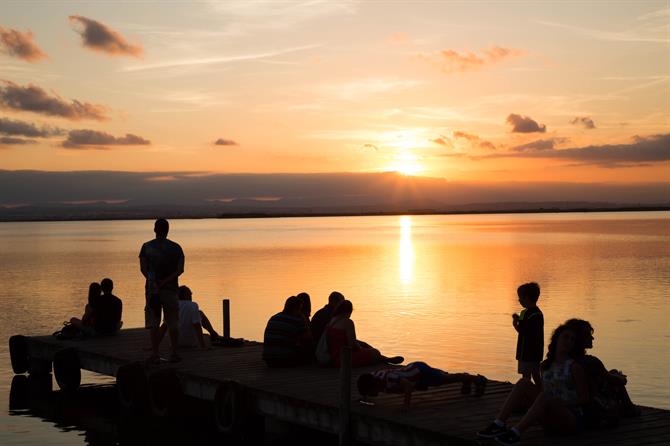La Albufera (Spanish for 'lagoon'), in the Valencia Province, is one of the largest wetlands on the Iberian peninsula, and it hasn't gone unnoticed by many birds, with more than 350 species found here. For some, it is their natural habitat, while for others, it is a stop along the way as they migrate south.
If you have the chance, definitely take a few hours or more to visit La Albufera; a trip here will be well worth it and you'll see that it isn't hard to relax your mind and spirit while surrounded by 21,000 hectares of spectacular landscapes.
Going to the heart of the area, the small town of El Palmar, is also a must. Located in the Province of Valencia, El Palmar, is 15 kilometres from the city of Valencia and is a very charming place.
The town is best known as an inspiration for Spanish novelist Vicente Blasco Ibanez who spent much time in Valencia; the town can be seen within some of his best-known novels including La Barraca and Cañas y Barro. He even created a successful television series based on the latter, in which outdoor shots were filmed in El Palmar. Since the series was made, El Palmar has become one of the most visited sites by tourists and by Valencians themselves.
Hiking and lagoon boat rides
The lagoon is separated from the Mediterranean by a thin sandy strip of just over a thousand metres of pine trees and sand dunes. This is better known as Dehesa del Saler, a forest of Mediterranean pines, many of which grow on top of the natural dunes. There are always nesting birds to spot nearby, while enjoying watching the wildlife from beautiful sites like el Estanque del Pujol and the marsh of El Saler.
At the site, there are hiking trails that range from 500 metres to 4 kilometres, most going in the north-south direction. There is an information centre next to El Palmar, from where you can see maps of the hiking routes.
While visiting, there are many options that will make for a great day. A boat ride is a good place to start. You might even able to convince the hospitable locals, so characteristic of Valencia, to give you a tour of the lake aboard their fishing boats.
Culinary wonders of El Palmar
Another thing you won't want to miss in El Palmar is the area's culinary excellence. Because we're talking about the Valencia region, rice is obviously a star ingredient. The most popular dish is the well-known Valencian paella, but All i Pebre isn't far behind - it's for the adventurous though, with a key ingredient being eel, which are typically found in the lagoon.
El Palmar definitely embraces the idea that Spaniards love to eat out and socialize; this town with a population of just 800 people is home to more than 30 restaurants.
Valencian Barraca
The typical houses you will see in the area include the Valencian Barraca, pictured below. These were once home to farmers and fishermen, but at present very few remain and these have become great icons of Valencian history. They are built from local materials such as mud, reeds, and wood.
This cabin is the oldest of El Palmar, dating back to the nineteenth century. Its walls are made of clay and the roof of wooden beams is covered by long reeds. The ceiling retains its original structure from over 200 years ago. The ground is made from pressed clay.
By the way, if you look closely at the picture above, you might notice that there is a for sale sign on the historic cabin. That's right, you can have your very own little historic Valencian cabin, but you would be responsible for the upkeep and to protect the cabin's original structure, which is such an important symbol of Valencian history.
Magical sunsets at the lagoon

An ideal place to finish off a beautiful day exploring La Albufera and El Palmar is at the small lookout at Dehesa del Saler, nearby the finishing shacks. From here you can witness breathtaking sunsets. From this viewpoint, there are some small docks where people of all ages sit to experience a magical and unforgettable evening.
After a day of hiking and site seeing, it's always a beautiful moment when the sky begins to flood with tones of pinks and oranges.
La Albufera comes from the Arabic al-buhayra, which means 'the little sea'. The word also appears in some Arabic poems with the meaning 'reflection of the sun'.
Wishing you a pleasant stay in Valencia and, of course, enjoy visiting beautiful El Palmar and La Albufera.
Directions to La Albufera from Valencia
Thanks to line 25, you can easily travel to La Albufera by bus from Valencia in a little under an hour. You can even bring a bike on the bus, so you'll be able to enjoy a bike ride and explore the lagoon.
